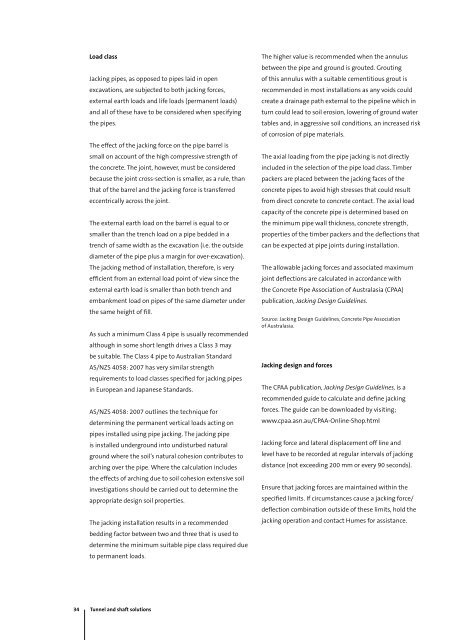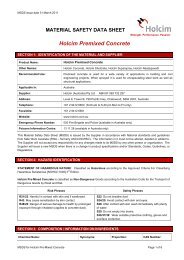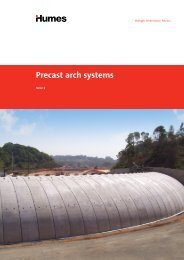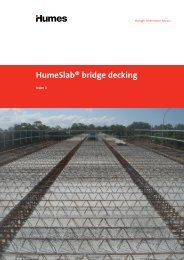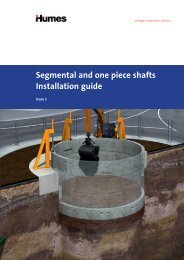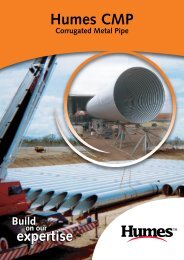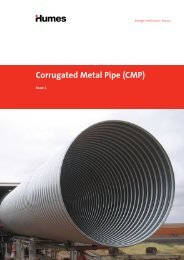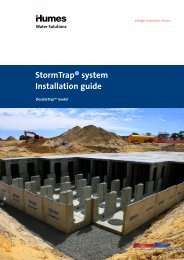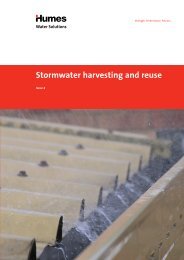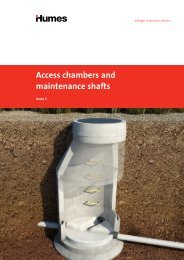Tunnel and shaft solutions brochure - Humes
Tunnel and shaft solutions brochure - Humes
Tunnel and shaft solutions brochure - Humes
Create successful ePaper yourself
Turn your PDF publications into a flip-book with our unique Google optimized e-Paper software.
Load class<br />
Jacking pipes, as opposed to pipes laid in open<br />
excavations, are subjected to both jacking forces,<br />
external earth loads <strong>and</strong> life loads (permanent loads)<br />
<strong>and</strong> all of these have to be considered when specifying<br />
the pipes.<br />
The effect of the jacking force on the pipe barrel is<br />
small on account of the high compressive strength of<br />
the concrete. The joint, however, must be considered<br />
because the joint cross-section is smaller, as a rule, than<br />
that of the barrel <strong>and</strong> the jacking force is transferred<br />
eccentrically across the joint.<br />
The external earth load on the barrel is equal to or<br />
smaller than the trench load on a pipe bedded in a<br />
trench of same width as the excavation (i.e. the outside<br />
diameter of the pipe plus a margin for over-excavation).<br />
The jacking method of installation, therefore, is very<br />
efficient from an external load point of view since the<br />
external earth load is smaller than both trench <strong>and</strong><br />
embankment load on pipes of the same diameter under<br />
the same height of fill.<br />
As such a minimum Class 4 pipe is usually recommended<br />
although in some short length drives a Class 3 may<br />
be suitable. The Class 4 pipe to Australian St<strong>and</strong>ard<br />
AS/NZS 4058: 2007 has very similar strength<br />
requirements to load classes specified for jacking pipes<br />
in European <strong>and</strong> Japanese St<strong>and</strong>ards.<br />
AS/NZS 4058: 2007 outlines the technique for<br />
determining the permanent vertical loads acting on<br />
pipes installed using pipe jacking. The jacking pipe<br />
is installed underground into undisturbed natural<br />
ground where the soil’s natural cohesion contributes to<br />
arching over the pipe. Where the calculation includes<br />
the effects of arching due to soil cohesion extensive soil<br />
investigations should be carried out to determine the<br />
appropriate design soil properties.<br />
The jacking installation results in a recommended<br />
bedding factor between two <strong>and</strong> three that is used to<br />
determine the minimum suitable pipe class required due<br />
to permanent loads.<br />
34 <strong>Tunnel</strong> <strong>and</strong> <strong>shaft</strong> <strong>solutions</strong><br />
The higher value is recommended when the annulus<br />
between the pipe <strong>and</strong> ground is grouted. Grouting<br />
of this annulus with a suitable cementitious grout is<br />
recommended in most installations as any voids could<br />
create a drainage path external to the pipeline which in<br />
turn could lead to soil erosion, lowering of ground water<br />
tables <strong>and</strong>, in aggressive soil conditions, an increased risk<br />
of corrosion of pipe materials.<br />
The axial loading from the pipe jacking is not directly<br />
included in the selection of the pipe load class. Timber<br />
packers are placed between the jacking faces of the<br />
concrete pipes to avoid high stresses that could result<br />
from direct concrete to concrete contact. The axial load<br />
capacity of the concrete pipe is determined based on<br />
the minimum pipe wall thickness, concrete strength,<br />
properties of the timber packers <strong>and</strong> the deflections that<br />
can be expected at pipe joints during installation.<br />
The allowable jacking forces <strong>and</strong> associated maximum<br />
joint deflections are calculated in accordance with<br />
the Concrete Pipe Association of Australasia (CPAA)<br />
publication, Jacking Design Guidelines.<br />
Source: Jacking Design Guidelines, Concrete Pipe Association<br />
of Australasia.<br />
Jacking design <strong>and</strong> forces<br />
The CPAA publication, Jacking Design Guidelines, is a<br />
recommended guide to calculate <strong>and</strong> define jacking<br />
forces. The guide can be downloaded by visiting;<br />
www.cpaa.asn.au/CPAA-Online-Shop.html<br />
Jacking force <strong>and</strong> lateral displacement off line <strong>and</strong><br />
level have to be recorded at regular intervals of jacking<br />
distance (not exceeding 200 mm or every 90 seconds).<br />
Ensure that jacking forces are maintained within the<br />
specified limits. If circumstances cause a jacking force/<br />
deflection combination outside of these limits, hold the<br />
jacking operation <strong>and</strong> contact <strong>Humes</strong> for assistance.


